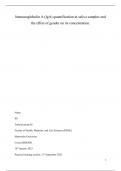Immunoglobulin A (IgA) quantification in saliva samples and
the effect of gender on its concentration.
Name
ID:
Tutorial group 02
Faculty of Health, Medicine, and Life Sciences (FHML)
Maastricht University
Course BBS2001
18th January 2023
Practical training session: 21st September 2022
1
, Introduction
On a daily basis, the human body is constantly being exposed to various microorganisms and
particulate matter that often pose a threat to health and homeostatic balance. The immune system has
the role of dealing with such invaders or foreign molecules. It has to detect and eradicate them while
simultaneously keeping a dynamic balance between overactivity, which causes allergies and
autoimmune diseases and underactivity, which may result in severe infections and tumor
accumulation (1). Based on its specificity of reaction, the immune system can be divided into innate
and adaptive defenses. Both of them are composed of a complex variety of cells, antimicrobial and
signaling molecules that are scattered throughout the blood circulation, the lymphoid system, and the
entry points of the body to pathogens. The innate defense system is characterized by its immediate but
nonspecific response. In contrast, the adaptive immune response is extremely precise and has a
memory feature but requires considerably more time to act (1). Furthermore, the adaptive immune
system is highly conserved among higher animals such as mammals and other vertebrates. For these
reasons, adaptive immunity has been a topic of active research in order to unveil its underlying
mechanisms. T cells and B lymphocytes orchestrate the response of the adaptive system. T cells act
directly on infected cells and cells of the innate system to eradicate the threat, whereas B lymphocytes
mediate their effects via the production and secretion of specialized immune proteins called antibodies
or immunoglobulins. Antibodies can neutralize toxins, activate the complement system, opsonize
bacteria, mark abnormal cells but also enhance the innate system (1).
Immunoglobulins can be divided into different classes, with regard to their structural differences and
their concentration predominance throughout the human body (2,3). The human immunoglobulin A
(IgA) is one of the most frequently produced and important antibodies when it comes to the first line
of defense against inhaled or ingested pathogens (2). This is due to the fact that high concentrations of
it can be detected in secreted fluids and mucosal sites, such as the oral, nasal cavities and the
intestines (2,3). The large surface area of these sites indicates that they are exposed to the
environment and subsequently to numerous pathogens. Furthermore, IgA is present in the serum as
well, with a concentration of approximately 2-3 mg/mL (2). All antibodies, including IgA, share a
common fundamental structure among them. They consist of four polypeptide chains and are
separated into two light and two heavy chains due to their differences in molecular weight. In an IgA
molecule there is an α type of heavy chain, which is divided into a variable part lying in the N-
terminal and a constant part found on the C terminal (3,4). The heavy chains are held together by
hinge regions (3, 5). The hinge regions hold together the Fab and Fc regions and play a role in the
functionality of the immunoglobulin (4, 5). The Fab region binds to the antigens, while the Fc region
can be used as an attachment point for a joining chain (J chain) to form polymers of the IgA (3, 5).
There are two subclasses of the IgA molecule, IgA1 and IgA2 (2). They differ in the number of
residues within the hinge region. IgA1 has an extended hinge region compared to the shorter hinge of
2




